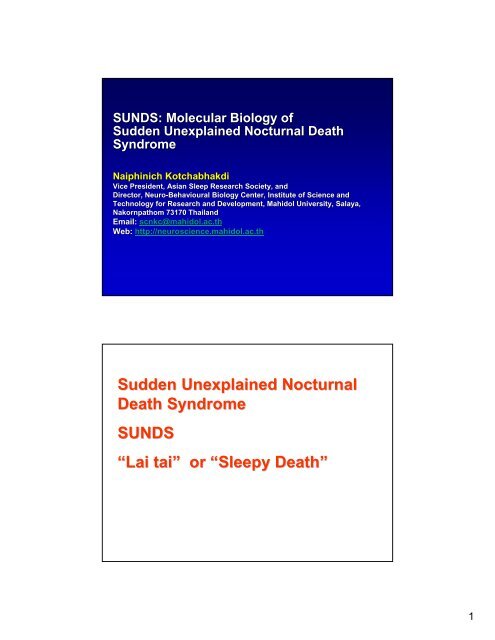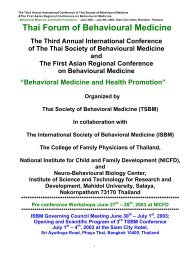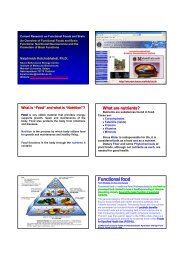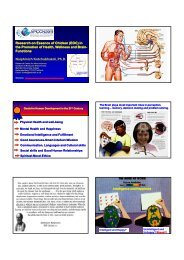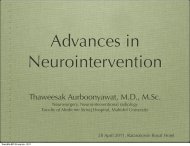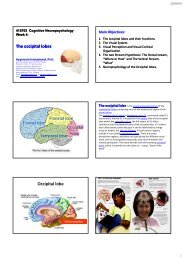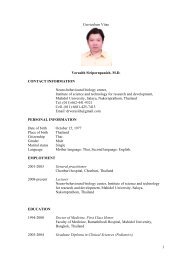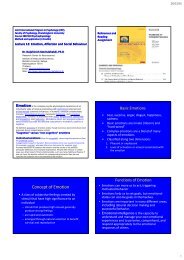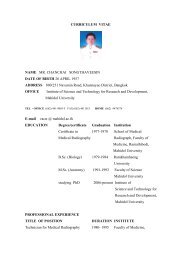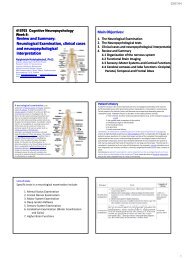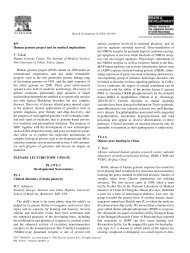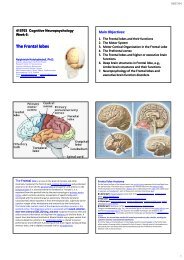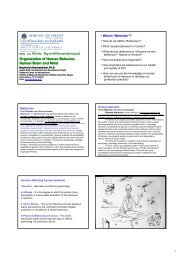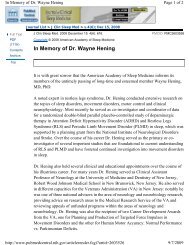Sudden Unexplained Nocturnal Death Syndrome SUNDS - Mahidol ...
Sudden Unexplained Nocturnal Death Syndrome SUNDS - Mahidol ...
Sudden Unexplained Nocturnal Death Syndrome SUNDS - Mahidol ...
You also want an ePaper? Increase the reach of your titles
YUMPU automatically turns print PDFs into web optimized ePapers that Google loves.
<strong>SUNDS</strong>: Molecular Biology of<br />
<strong>Sudden</strong> <strong>Unexplained</strong> <strong>Nocturnal</strong> <strong>Death</strong><br />
<strong>Syndrome</strong><br />
Naiphinich Kotchabhakdi<br />
Vice President, Asian Sleep Research Society, and<br />
Director, Neuro-Behavioural Biology Center, Institute of Science and<br />
Technology for Research and Development, <strong>Mahidol</strong> University, Salaya,<br />
aya,<br />
Nakornpathom 73170 Thailand<br />
Email: scnkc@mahidol.ac.th<br />
Web: http://neuroscience.mahidol.ac.th<br />
<strong>Sudden</strong> <strong>Unexplained</strong> <strong>Nocturnal</strong><br />
<strong>Death</strong> <strong>Syndrome</strong><br />
<strong>SUNDS</strong><br />
“Lai tai” or “Sleepy <strong>Death</strong>”<br />
1
SUDDEN DEATH<br />
1. <strong>Sudden</strong> <strong>Unexplained</strong> <strong>Death</strong> <strong>Syndrome</strong> (SUDS)<br />
2. <strong>Sudden</strong> <strong>Unexplained</strong> <strong>Nocturnal</strong> <strong>Death</strong><br />
<strong>Syndrome</strong> (<strong>SUNDS</strong>)<br />
3. <strong>Sudden</strong> Infant <strong>Death</strong> <strong>Syndrome</strong> (SIDS)<br />
(or<br />
“Crib<br />
<strong>Death</strong>”)<br />
SUDDEN UNEXPLAINED<br />
DEATH SYNDROME (SUDS)<br />
DEFINITION:<br />
<strong>Sudden</strong> death in previously (within past 24 hrs) healthy<br />
individuals, without known predisposing illness;<br />
occurring in persons of both sexes, from age 20-44 yrs;<br />
with no definitive pathological findings; no homicidal<br />
or suicidal indications.<br />
4
<strong>Sudden</strong> <strong>Unexplained</strong> <strong>Nocturnal</strong> <strong>Death</strong><br />
<strong>Syndrome</strong><br />
(<strong>SUNDS</strong>)<br />
According to the 1990 ICSD- International<br />
Classification of Sleep Disorders: Diagnostic and<br />
Coding Manual, <strong>Sudden</strong> unexplained nocturnal<br />
death syndrome (<strong>SUNDS</strong>) is characterized by<br />
sudden death during sleep in healthy young adults,<br />
particularly of Southeast Asian descent.<br />
Neither clinical history nor autopsy provides<br />
an explanation for the cause of death. According to<br />
witnesses of <strong>SUNDS</strong>, the first signs are choking,<br />
gasping, and labored respiration (without wheezing<br />
or stridor). Attempts to awaken the person are<br />
unsuccessful. In several successfully resuscitated<br />
patients, ventricular fibrillation was subsequently<br />
detected.<br />
5
<strong>SUNDS</strong> are most often found among<br />
Laotian, Kampuchean, and Vietnamese male<br />
refugees, and Thai males from the Northeastern<br />
part of Thailand between the ages of 25 and 44<br />
years. There are descriptive terms in the Asian<br />
languages which suggest that <strong>SUNDS</strong> has long<br />
been recognized. Synonyms (translations) include<br />
“Lai-Tai” and “Non-Lai-Tai” (Sleep death) in<br />
Thai and Laotian respectively, “Bangungut or<br />
Gangungut” (To arise and moan) in Tagalog of<br />
the Philippines, and “Pokkuri” (<strong>Sudden</strong> death) in<br />
Japanese.<br />
Studies have failed to identify any social,<br />
religious, or work-related activity, rituals, or<br />
specific daytime events that could be associated<br />
with <strong>SUNDS</strong>. Acutely stressful events were found<br />
in few cases (4 of 51 cases in one study). Neither<br />
exposure to chemical and biological toxins nor<br />
use of drugs or alcohol has been implicated in the<br />
death. Sleep terrors have been reported to occur<br />
frequently in patients who subsequently have<br />
been <strong>SUNDS</strong> victims.<br />
6
Centers for Disease Control :(CDC), Atlanta, USA<br />
7
N. Kotchabhakdi et al 98<br />
แผนที่แสดงการกระจายของภูมิลําเนาของผูตายดวยโรคใหลตายในภาคอีสาน<br />
9
Kotchabhakdi et al 1992<br />
N. KOTCHABHAKDI et al 1992<br />
11
In interviews with very old living Northeastern<br />
Thais, it appears that ‘Lai Tai’ has probably<br />
been present in the region for quite a long time,<br />
as it is very well-known in the local folklore, in<br />
traditional ‘folk medicine’ and among ‘healers’.<br />
Mythical beliefs relate ‘Lai Tai’ to the spirits<br />
of dead widows who try to harm or reclaim the<br />
lives of males who had deceived them, in either<br />
the present or some previous life.<br />
12
The majority of SUDS victims died during<br />
night-time sleep ( >90% ) or collapsed while<br />
resting, rather than during active exertion;<br />
hence,<br />
SUDS<br />
(<strong>Sudden</strong> <strong>Unexplained</strong> <strong>Death</strong> <strong>Syndrome</strong>)<br />
is now referred to more frequently as:<br />
<strong>SUNDS</strong><br />
(<strong>Sudden</strong> <strong>Unexplained</strong> <strong>Nocturnal</strong> <strong>Death</strong> <strong>Syndrome</strong>)<br />
Definition:<br />
‘Lai Tai’ or <strong>SUNDS</strong><br />
<strong>Sudden</strong> death during sleep (mainly nocturnal sleep,<br />
but may also occur during daytime resting or<br />
napping) in previously healthy individuals, without<br />
known predisposing illness, predominantly in<br />
males with ethnic origins in the Northeastern<br />
region of Thailand, ages from 21-45 yrs, and with no<br />
definitive pathological findings.<br />
13
<strong>SUNDS</strong> has been reported from:<br />
• southern parts of China<br />
• Indochina (Laos, Cambodia, Vietnam,<br />
and among certain small tribes, e.g.,<br />
the Hmong)<br />
• Northeastern region of Thailand<br />
(E’sarn)<br />
• Philippines<br />
• Japan<br />
• Mongolia<br />
14
แผนที่แสดงประเทศในทวีปเอเชียที่มีรายงานของผูตายดวยอาการโรคใหลตาย<br />
15
?<br />
N. Kotchabhakdi et al 98<br />
16
N. Kotchabhakdi et al 1998<br />
RELATED SYNDROMES<br />
1. Sleep Apnea:<br />
-- Upper Airway Obstructive<br />
-- Central<br />
-- Mixed type<br />
-- Sleep Breathing Disorders<br />
2. Autonomic Dystonia<br />
3. Prolonged QT Interval <strong>Syndrome</strong><br />
4. Brugada <strong>Syndrome</strong> (?)<br />
17
Risk Factors and Hypotheses<br />
on the Etiology of SUDS<br />
1. Cardiac<br />
-- Prolonged QT Interval <strong>Syndrome</strong><br />
-- Brugada <strong>Syndrome</strong><br />
-- <strong>Sudden</strong> Heart Block<br />
2. Renal tubular acidosis (RTA)<br />
3ใ Neurogenic<br />
--<br />
-- Dysautonomia<br />
-- Abnormal reflex bradycardia<br />
4. Sleepleep Apnea<br />
5. Respiratory<br />
Arrest<br />
Risk Factors and Hypotheses<br />
on the Etiology of SUDS<br />
(continued)<br />
6. Ionic Imbalance (e.g., Hypokalemia)<br />
7. Nutritional Deficiencies (e.g., B-Vitamins)<br />
8. Toxic Substances (e.g., PVC)<br />
9. Infectious Processes (e.g., Influenza Virus A)<br />
10. Genetic Abnormalities<br />
18
Kirschner, R.H.; Eckner, F.A.; Baron, R.C. : The<br />
cardiac pathology of sudden unexplained<br />
nocturnal death in Southeast Asian refugees.<br />
JAMA (KFR) 1986 Nov 21, 256(19), p.2700-5.<br />
Of 18 hearts examined, 14 showed cardiomegaly,<br />
characteristic of increased cardiac work load, 17 had<br />
conduction system anomalies, including persistent fetal<br />
dispersion of the A-V node and/or Bundle of His (14),<br />
accessory conduction fiber connections (13), and<br />
congenital heart block (1). Together with associated<br />
variations in cardiac base structure, these abnormalities<br />
suggest a common aberrant developmental process.<br />
19
Okoye, M.I.; Congdon, D.E.; Mueller, W.F. Jr.:<br />
Asymmetric septal hypertrophy of the heart: New<br />
findings concerning the possible etiology of sudden<br />
deaths in five males.<br />
Am J Forensic Med Pathol (3HC) 1985 Jun: 6(2),<br />
p.105-24.<br />
In 5 male SUDS cases, autopsy revealed only<br />
asymmetric septal hypertrophy (ASH). These<br />
abnormalities in the conducting system and ventricular<br />
myocardium are excellent anatomical substrates for<br />
hemodynamic impairment and lethal arrhythmias,<br />
triggered by hypoxia, increased oxygen demand or<br />
abnormal sympathetic stimulus.<br />
Drescher, J.; Zink, P.; Verhagen, W.; Flik, J.;<br />
Milbradt, H. : Recent influenza virus A<br />
infections in forensic cases of sudden<br />
unexplained death.<br />
Arch Virol (8L7) 1987: 92(1-2), p. 63-76.<br />
84 forensic necropsy cases of SUDS were found to have<br />
a significantly higher rate of influenza virus A (H3N2)<br />
infection than either matched controls of the general<br />
population or a group of forensic necropsy cases with<br />
known cause of death (non-SUD).<br />
20
Munger RG, Prineas RJ, Crow<br />
RS, Changbumrung S, Keane V,<br />
Wangsuphachart V, Jones MP.<br />
Prolonged QT interval and risk<br />
of sudden death in South-East<br />
Asian men. Lancet 1991, 338,<br />
280-281.<br />
According to a group of cardiologists, the clinical features of <strong>SUNDS</strong> may include<br />
ST-segment elevation in the right precordial leads (V1–V3), inconsistently<br />
associated with right bundle branch block (RBBB) (Fig. 1) (2,3) and ventricular<br />
tachycardia and fibrillation (VF) on surface electrocardiogram (ECG). These<br />
clinical characteristics are similar to those of the Brugada syndrome, a disorder<br />
diagnosed in individuals of European descent.<br />
21
1 Baron,R.C., Thacker,S.B., Gorelkin,L., Vernon,A.A., Taylor,W.R. and Choi,K. (1983) <strong>Sudden</strong> death among<br />
Southeast Asian refugees. An unexplained nocturnal phenomenon. J. Am. Med. Assoc., 250, 2947–2951<br />
2 Nademanee,K., Veerakul,G., Nimmannit,S., Chaowakul,V., Bhuripanyo,K., Likittanasombat,K.,<br />
Tunsanga,K., Kuasirikul,S., Malasit,P., Tansupasawadikul,S. et al. (1997) Arrhythmogenic marker for the<br />
sudden unexplained death syndrome in Thai men. Circulation, 96, 2595–2600<br />
3 Gilbert,J., Gold,R.L., Haffajee,C.I. and Alpert,J.S. (1986) <strong>Sudden</strong> cardiac death in a southeast Asian<br />
immigrant: clinical, electrophysiologic and biopsy characteristics. Pacing Clin. Electrophysiol., 9, 912–<br />
914.<br />
22
The genetic cause of the Brugada syndrome was initially<br />
described by our group and shown to be due to mutations<br />
in the cardiac sodium channel gene, SCN5A. This has now<br />
been confirmed by others (7,8). In previous publications, we<br />
and others demonstrated that mutant sodium channels<br />
have a reduced sodium channel current (INa) due to rapid<br />
inactivation of the current or failure of the channel to<br />
express currents (9,10). Due to the apparent clinical<br />
similarities between Brugada syndrome and <strong>SUNDS</strong>, we<br />
speculated that these could be allelic disorders (or even the<br />
same disease). In this report, we describe the molecular<br />
analysis of patients with <strong>SUNDS</strong> and identify mutations in<br />
SCN5A, confirming this disorder to be genotypically,<br />
phenotypically and functionally identical to Brugada<br />
syndrome.<br />
7 Bezzina,C., Veldkamp,M.W., van Den Berg,M.P., Postma,A.V., Rook,M.B., Viersma,J.W., van Langen,I.M., Tan-Sindhunata,G., Bink Boelkens,M.T.,<br />
van Der Hout,A.H. et al. (1999) A single Na(+) channel mutation causing both long-QT and Brugada syndromes. Circ. Res., 85, 1206–1213<br />
8 Rook,M.B., Alshinawi,C.B., Groenewegen,W.A., van Gelder,I.C., van Ginneken,A.C., Jongsma,H.J., Mannens,M.M. and Wilde,A.A. (1999) Human<br />
SCN5A gene mutations alter cardiac sodium channel kinetics and are associated with the Brugada syndrome. Cardiovasc. Res., 44, 507–517<br />
9 Chen,Q., Kirsch,G.E., Zhang,D., Brugada,R., Brugada,J., Brugada,P., Potenza,D., Moya,A., Borggrefe,M., Breithardt,G. et al. (1998) Genetic basis<br />
and molecular mechanism for idiopathic ventricular fibrillation. Nature, 392, 293–296<br />
10 Dumaine,R., Towbin,J.A., Brugada,P., Vatta,M., Nesterenko,D.V., Nesterenko,V.V., Brugada,J., Brugada,R. and Antzelevitch,C. (1999) Ionic<br />
mechanisms responsible for the electrocardiographic phenotype of the Brugada syndrome are temperature dependent. Circ. Res.,85, 803–809.<br />
Mutation analysis<br />
Ten probands with clinical evidence of <strong>SUNDS</strong> were screened for<br />
mutations in KVLQT1 (11), HERG (11), SCN5A (9,11), minK (12)<br />
and MiRP1 (13) using single-strand DNA conformation<br />
polymorphism (SSCP) analysis, denaturing high-performance liquid<br />
chromatography (DHPLC) and DNA sequencing. In three patients<br />
(M030, M032, M033), SCN5A mutations were identified. No mutations<br />
were identified in any of the other genes screened. Patient M030 is a<br />
sporadic case, whereas the other two cases were probands of<br />
families. One of these was a family with multiple affected individuals<br />
(family M032), and apparent autosomal dominant inheritance. The<br />
second family (M033) included a pair of affected Japanese dizygotic<br />
twins. One twin died unexpectedly during sleep at 4 months of age.<br />
The other twin had frequent VF episodes at 6 months of age and has<br />
been discussed previously (14). This living child and other family<br />
members were studied.<br />
11 Splawski,I., Shen,J., Timothy,K.W., Vincent,G.M., Lehmann,M.H. and Keating,M.T. (1998) Genomic structure of three<br />
long QT syndrome genes: KVLQT1, HERG and KCNE1. Genomics, 51, 86–97<br />
12 Schulze-Bahr,E., Wang,Q., Wedekind,H., Haverkamp,W., Chen,Q., Sun,Y., Rubie,C., Hordt,M., Towbin,J.A.,<br />
Borggrefe,M. et al. (1997) KCNE1 mutations cause Jervell and Lange-Nielsen syndrome. Nat. Genet., 17, 267–268<br />
13 Abbott,G.W., Sesti,F., Splawski,I., Buck,M.E., Lehmann,M.H., Timothy,K.W., Keating,M.T. and Goldstein,S.A. (1999)<br />
MiRP1 forms IKr potassium channels with HERG and is associated with cardiac arrhythmia. Cell, 97, 175–187<br />
14 Suzuki, H., Torigoe, K, Numata, O. and Yazaki, S. (2000) Infant case with a malignant form of Brugada syndrome. J.<br />
Cardiovasc. Electrophysiol., 11, 1277–1280.<br />
23
However, Brugada syndrome,<br />
predominantly found among western<br />
population, and other cardiac pathology<br />
are related to autosomal genes,<br />
therefore, they are inconsistent with<br />
South-east Asian <strong>SUNDS</strong><br />
epidemiological data which are<br />
predominantly males.<br />
Also, they should have had some previous<br />
history of illness, symptoms or abnormalities.<br />
26
Munger, R.G. : <strong>Sudden</strong> death in sleep of Laotian-<br />
Hmong refugees in Thailand: a case-control<br />
study.<br />
AM J Public Health (3XW) 1987 Sep: 77(9), p. 1187-<br />
90.<br />
16 <strong>SUNDS</strong> cases were studied in Northeastern Thailand,<br />
similar to those among SEA refugees in the USA.<br />
Associations were found between Green-Hmong<br />
subgroup membership, a family history of sudden death<br />
and previous non-fatal sleep disturbances, suggesting that<br />
this is a regional phenomenon in culturally and<br />
genetically distinct populations.<br />
Munger RG, Booton EA. Thiamine and sudden<br />
death in sleep of South-East Asian refugee.<br />
Lancet. 1990 May 12; 335(8698): 1154-1155.<br />
27
Munger RG, Booton EA.<br />
Thiamine and sudden death<br />
in sleep of South-East Asian<br />
refugee. Lancet. 1990 May 12;<br />
335(8698): 1154-1155.<br />
28
Between 1990 – 1992,<br />
intensive health promotions,<br />
including vitamin and mineral<br />
supplements,<br />
did not alter the incidence rates of<br />
SUDS or <strong>SUNDS</strong> among the<br />
intervention groups of the target<br />
population, especially young Thai<br />
laborers working abroad, in Singapore,<br />
Malaysia, Brunei, etc.<br />
In Singapore and Thailand,<br />
prolonged EKG monitoring and<br />
echocardiographic studies did not<br />
reveal any significantly higher<br />
incidence of cardiac abnormalities<br />
among the target group than in the<br />
general population.<br />
29
Melles, R.B. : Night terrors and <strong>Sudden</strong><br />
<strong>Unexplained</strong> <strong>Nocturnal</strong> <strong>Death</strong>.<br />
Med. Hypotheses (MOM) 1988 Jun: 26(2), p. 149-154.<br />
Post mortem analysis of <strong>SUNDS</strong> victims has disclosed a<br />
high incidence of cardiac conduction defects in many<br />
cases. Also, a careful review of terminal events suggests<br />
the additional presence of night terrors, a sleep disorder<br />
characterized by vocalization, motor activity, a nonarousable<br />
state and severe autonomic discharge.<br />
N. Kotchabhakdi et al 98<br />
30
In interviews with very old living Northeastern<br />
Thais, it appears that ‘Lai Tai’ has probably<br />
been present in the region for quite a long time,<br />
as it is very well-known in the local folklore, in<br />
traditional ‘folk medicine’ and among ‘healers’.<br />
Mythical beliefs relate ‘Lai Tai’ to the spirits<br />
of dead widows who try to harm or reclaim the<br />
lives of males who had deceived them, in either<br />
the present or some previous life.<br />
32
Several families in Northeastern Thailand have<br />
been identified as having<br />
(N = 24 have been studied so far, as of 2003)<br />
2 - 3 generations of <strong>SUNDS</strong> victims.<br />
Probands from these 24 families have significantly<br />
higher incidences of sleep disturbances,<br />
especially sleep apnea<br />
--- resulting in O2 desaturation<br />
and episodic bradycardia<br />
--- than control families.<br />
38
Is <strong>SUNDS</strong><br />
an X-linked recessive<br />
inheritance<br />
?<br />
What are the possible gene – protein markers on<br />
the X chromosome??<br />
• pyruvate dehydrogenase<br />
• ornithine carbamyl transferase<br />
• glyceraldehyde-3 phosphate dehydrogenase<br />
• a-phosphorylase kinase<br />
• monoamine oxidase A and B<br />
• glycine receptor<br />
• GABA receptor<br />
39
MAO Substrate sensitivity<br />
MAO-A<br />
MAO-B<br />
Serotonin<br />
Norepinephrine<br />
Epinephrine<br />
Phenylethylamine<br />
Benzylamine<br />
Alternative pathways and enzymes:<br />
MAO Monoamine oxidae<br />
COMT Catecholamine O-methy transferase<br />
40
Midline Dorsal Raphe Nucleus (Controls vs <strong>SUNDS</strong>)<br />
300.00<br />
250.00<br />
Number of cells counted<br />
200.00<br />
150.00<br />
100.00<br />
Control<br />
<strong>SUNDS</strong><br />
50.00<br />
0.00<br />
DRN-A DRN-B DRN-AB<br />
49
Medulla<br />
30.00<br />
25.00<br />
Number of cells counted<br />
20.00<br />
15.00<br />
10.00<br />
Control<br />
<strong>SUNDS</strong><br />
5.00<br />
0.00<br />
DRN-A DRN-B DRN-AB<br />
Locus Ceruleus (Controls vs <strong>SUNDS</strong>)<br />
600.00<br />
500.00<br />
Number of cells counted<br />
400.00<br />
300.00<br />
200.00<br />
Control<br />
<strong>SUNDS</strong><br />
100.00<br />
0.00<br />
LC-A LC-B LC-AB<br />
50
The “Serotonin excess” hypothesis.<br />
The last genomic<br />
aspects of <strong>SUNDS</strong> ? NO<br />
What are the<br />
environmental or<br />
behavioral trigger<br />
factors?<br />
51
Have a good night sleep<br />
and sweet dream<br />
and<br />
REM beahvioral disorde<br />
no REM<br />
<strong>SUNDS</strong><br />
Thank you<br />
52


